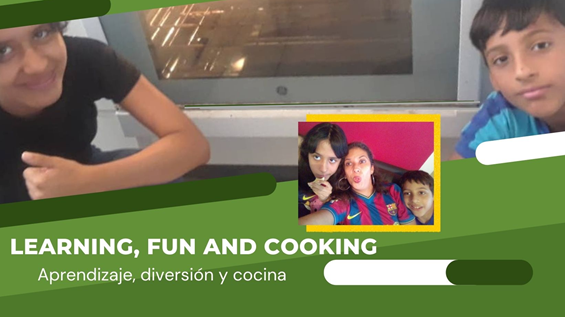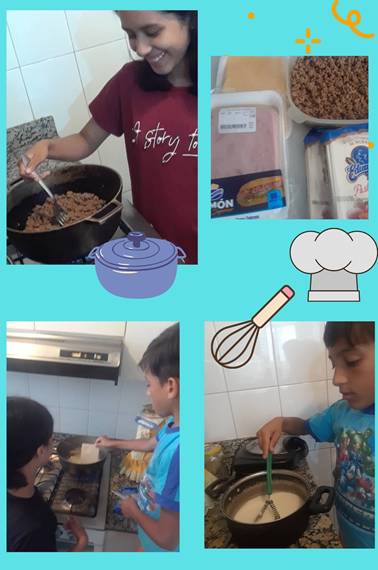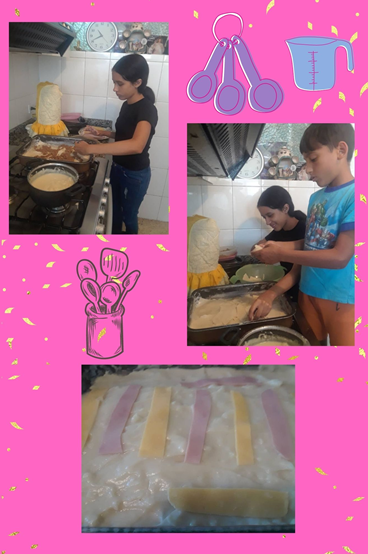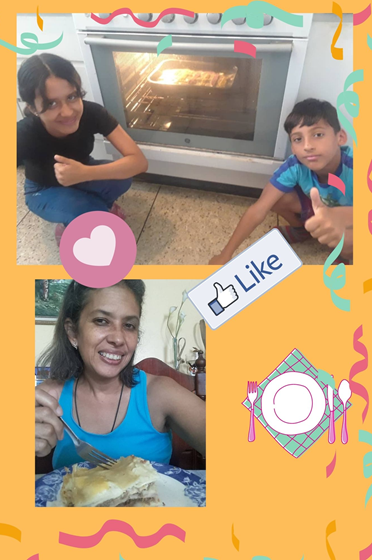Hello to all readers and the @Motherhood community today I want to share with you a learning I got from two of my favorite life teachers, my daughter and my nephew.
Hola a todos los lectores y a la comunidad de @Motherhood hoy quiero compartir con ustedes un aprendizaje que me dieron dos de mis maestros de vida preferidos, mi hija y mi sobrino.

Every day we learn, we never stop acquiring new experiences and life lessons. As a mother, I always want the best for my daughter, however I forget that she is growing up and I make the mistake of overprotecting her in activities that she can do on her own with only my supervision.
As the name implies, overprotection is the parents' overprotection of their children. Sometimes, this happens by wanting to create an ideal environment for the children to avoid the mistakes that the parents may have made; in other cases, as in mine, to be faithful to the upbringing they gave me, because with this reflection I realize that they were also overprotective of me.
Todos los días aprendemos, no dejamos de adquirir nuevas experiencias y enseñanzas de vida. Como mama, siempre quiero lo mejor para mi hija, sin embargo se me olvida que ella está creciendo y cometo el error de sobreprotegerla en actividades que puede realizar ella por su cuenta con solo mi supervisión.
Como lo dice su nombre, la sobreprotección es el exceso de protección de los padres a sus hijos. A veces, esto pasa por querer crear un entorno ideal a los hijos para evitar los errores que pudieron haber cometido los padres; en otros casos, como en el mío, ser fiel a la crianza que me dieron, pues con esta reflexión me doy cuenta que también fueron sobreprotectores conmigo.
There are no perfect parents, because we are not 100% perfect, so it is time to tell them how things happened:
In a post I made a few weeks ago, I commented that my favorite food as a child was the pasticho and thanks to that I was motivated to plan to make one, that same week I went with my mom to buy the ingredients, however, it could not be done on the scheduled day. My daughter didn't remember and my nephew didn't know what a pasticho was, since we hadn't made one for a long time. Their curiosity made them research, search the internet and look at recipes, they got excited and started asking when we would make it. Days went by and they kept asking... Tia, when are you going to make the "Lasagna", of course, in her research she found out that lasagna is prepared the same way as pasticho, as we say in Venezuela.
My answer was that I couldn't this week because I had a lot of things to do, plus I had already used up some of the ingredients and had to buy them again.
Since I did not speak up, they were ready to give us a solution:
"You can relax, we are going to cook, we are going to make the pasticho."
My immediate reaction was one of fear...😲 my overprotection first showed me the dangers of the kitchen, "be careful with the flame", "don't do that or you'll cut yourself", "I'd better do it myself so you don't get dirty" "don't get on there because you might fall" worrying about what could happen to them. And of course my answer was "NO", to which my daughter asked me to explain the reason, if her cousin helps her mother at home why can't they do it here.
No hay padres perfectos, porque no somos 100% perfectos, así que es momento de contarles como fueron los hechos:
En un post que realice hace unas semanas, comente que mi comida favorita de niña era el pasticho y gracias a eso me motive a planificar para hacer uno, esa misma semana fui con mi mama a comprar los ingredientes, sin embargo, no se pudo hacer el día previsto. Mi hija no recordaba y mi sobrino no sabía que era un pasticho, pues tuvimos mucho tiempo que no lo hacíamos. Su curiosidad los hizo investigar, buscar por internet y ver recetas, se entusiasmaron y comenzaron a preguntar cuando lo haríamos. Pasaron los días y ellos seguían preguntando… Tía cuando vas hacer la “Lasaña”, claro, en su investigación consiguió que la lasaña se prepara igual que el pasticho, como le decimos en Venezuela.
Mi respuesta era que esta semana no podía porque tenía muchas cosas que hacer, además ya había consumido parte de los ingredientes y los tenía que comprar de nuevo.
En vista de que yo no me manifestaba, ellos se dispusieron a darnos una solución:
“Ustedes tranquilas, nosotros vamos a cocinar, vamos a hacer el pasticho”
Mi reacción inmediata fue de susto… 😲 mi sobreprotección lo primero que me mostro fueron los peligros de la cocina, “cuidado con la llama”, “no hagas eso que te cortas”, “mejor lo hago yo para que no te manches” “no te montes allí porque te puedes caer” preocupándome de lo que les pudiera pasar. Y por supuesto mi respuesta fue que "NO", a lo que mi hija me pidió le explicara la razón, si su primo ayuda a su mama en su casa porque no pueden hacerlo aquí.

It was at that moment that I "dropped the ball" and as the saying goes, I realized how I was acting. I did indeed want to "protect" but without the "envelope", so with a long sigh, I told them that it was okay that they could make the pasticho with adult supervision.
I have to trust in their abilities because if I don't give them the opportunity and do things for them, they will feel that they are not capable of doing it. By overprotecting them I limit them to explore new things for fear of something happening to them or putting them in danger, I transmit my insecurities to them, but because of the love I have for them it is necessary for them to experiment, learn and have fun.
Parental motivation is important when our children show an interest in performing any task that they find fun and feel capable of doing it, encourage and support them because not doing so will restrict those potentials that are being manifested.

The practice of cooking in children brings many benefits in their development and learning, they learn to use the units of measurement, to organize the ingredients and utensils, they know better the food, its aromas, textures, flavor and consistency; It helps them with their motor skills, encourages teamwork when done as a family, develops creativity, helps them to focus on a goal, to follow a process step by step, learn to plan and organize, also helps them to work patience and concentration in what they are doing, manage frustration and can learn to handle the fear of failure, in addition to improving their confidence to be doing an adult work.
However, do not fail to emphasize the importance of safety in the kitchen, supervising and teaching them to use utensils, to protect themselves from heat, to maintain order and cleanliness in the kitchen as a rule when we work in it.😃
En ese momento fue que “me cayó la locha” y como lo refiere ese refrán, me di cuenta de como estaba actuando. En efecto quiero “proteger” pero sin el “sobre”, así que con un largo suspiro, les dije que estaba bien que podían hacer el pasticho con la supervisión de un adulto.
Me toco confiar en sus capacidades porque si no les doy la oportunidad y les hago las cosas, sentirán que ellos no son capaces de hacerlo. Al sobreprotegerlos los limito a que exploren cosas nuevas por miedo a que les suceda algo o a ponerlos en peligro, les trasmito mis inseguridades, pero por ese amor que les tengo es necesario que ellos experimenten, aprendan y se diviertan.
La motivación de los padres es importante cuando nuestros hijos manifiestan un interés en realizar cualquier tarea que les parece divertida y se sienten capaces de hacerlo, animarlos y apoyarlos porque de no hacerlo se le restringe esos potenciales que se están manifestando.

La práctica de cocina en los niños trae muchos beneficios en su desarrollo y aprendizaje, aprenden a utilizar las unidades de medida, a organizar los ingredientes y utensilios, conocen mejor los alimentos, sus aromas, texturas, sabor y consistencia; los ayuda con sus habilidades motrices, fomenta el trabajo en equipo cuando se hace en familia, desarrollan la creatividad, los ayuda a enfocarse en una meta, a seguir un proceso paso a paso, aprenden a planificar y organizarse, los ayudan también a trabajar la paciencia y la concentración en lo que están haciendo, gestionan la frustración y pueden aprender a manejar el miedo al fracaso, además que mejora su confianza al estar haciendo una labor de adultos.
Sin embargo no deje de hacerles énfasis en la importancia de la seguridad en la cocina, supervisando y enseñando a utilizar los utensilios, a protegerse del calor, a mantener el orden y la limpieza de la cocina como norma cuando trabajamos en ella. 😃

Now I will briefly share with you the recipe they made and its step-by-step: / Ahora les comparto brevemente la receta que realizaron y su paso a paso:
Pasticho
Ingredients:
2 packages of pasta for pasticho
½ kilo of ground beef
½ kilo of yellow cheese
½ kilo of ham
Wheat flour
2 cups of milk
Chopped seasoning (tomato, onion, garlic, paprika, aji dulce)
Vegetable oil
Salt and cumin to taste
Preparation:
Sauté the meat with its seasonings, add water and salt, let it cook. Boil the pasta with enough water, salt and a little bit of oil. Make the white sauce with 2 cups of milk and dilute a cup of wheat flour, add salt and cumin to taste, let it cook until it thickens, stirring to avoid lumps.
Pasticho
Ingredientes:
2 paquetes de pasta para pasticho
½ kilo de carne molida
½ kilo de queso amarillo
½ kilo de Jamón
Harina de trigo
2 tazas de leche
Aliño picadito (tomate, cebolla, ajo, pimentón, ají dulce)
Aceite vegetal
Sal y comino al gusto
Preparación:
Sofreír la carne con sus aliños, agregar agua y sal, dejar cocinar. Salcochar la pasta con suficiente agua, sal y un poquito de aceite. Hacer la salsa blanca con 2 tazas de leche y diluir una taza de harina de trigo, agregar sal y comino al gusto, dejar cocinar hasta que espese revolviendo para evitar grumos.

In a tortera grease with butter and pour a little wheat flour so that it does not stick. Cover the tray with a first layer of pasta, cover the pasta with meat, another layer of ham and on top of that a layer of cheese, cover with white sauce and repeat the procedure one more time. At the end a last layer of pasta was covered with white sauce and decorated with cheese and ham strips.
Se llevó al horno por media hora a 350 grados c. Receta para 8 personas.
En una tortera engrasar con mantequilla y echar un poco de harina de trigo para que no se pegue. Se cubre la bandeja con una primera capa de pasta, encima se cubre la pasta con carne, otra capa de jamón y sobre esa una capa de queso, se bañó con salsa blanca y se repitió el procedimiento una vez más. Al final una última capa de pasta que se cubrió con salsa blanca y se adornó con queso y jamón en tiras.
Se llevó al horno por media hora a 350 grados c. Receta para 8 personas.

What did they like most about the experience?
My daughter expressed her gratitude for having been given permission to do it, that besides learning a new recipe, she learned about her family history, anecdotes, memories and having shared them with her family. She had fun and what she liked the most was the meat because she made it by herself.
My nephew said he was happy because it's something he likes to do and he wants to be a chef when he grows up.
And I tell them that he really has talent, style and he documents himself before doing it, that helped him to be more aware of what he was doing, he enjoys it, but he also takes it seriously.
Additionally, it was very good.😋
¿Qué fue lo que más les gusto de la experiencia?
Mi hija manifestó el agradecimiento por haberle dado el permiso de hacerlo, que aparte de conocer una receta nueva supo la historia familiar de ella, las anécdotas, recuerdos y el haber compartido en familia. Que se divirtió y lo que más le gusto hacer fue la carne porque la hizo ella sola.
Mi sobrino dijo que se sintió feliz porque es algo que le gusta hacer y que quiere ser chef cuando sea grande.
Y les digo que de verdad él tiene talento, estilo y se documenta antes de hacerlo, eso lo ayudo a tener más conciencia de lo que realizaba, lo disfruto y pero también se lo tomo en serio.
Además que les quedo buenísimo.😋

Now I realize the importance of allowing children to help and participate in the preparation of a dish or recipe, which in principle can be simple and under supervision, especially in these times where there are television programs and contests where they are encouraged to perform these activities.
For that reason, preparing that recipe became a fun space because we turned it into a game where they cooked and I made a report where they explained to me how they made the recipe, I took pictures and we enjoyed the experience.
Ahora me doy cuenta de la importancia de permitir que los niños ayuden y participen en la preparación de algún plato o receta, que en principio pueden ser sencillas y bajo supervisión, y más en estos tiempos donde existen programas y concursos televisivos donde los incentivan a realizar estas actividades.
Por esa razón, preparar esa receta se hizo un espacio divertido porque lo convertimos en un juego donde ellos cocinaban y yo les hacia un reportaje y me explicaban como realizaban la receta, les tome fotos y disfrutamos la experiencia.
Thanks for reading this far, we are reading each other. / Gracias por leer hasta acá nos estamos leyendo.
• Photos from my personal archive / Fotos de mi archivo personal
• Banners, dividers and layouts in Canva with the elements available in its free version / Banners, separadores y diseñados en Canva con los elementos disponibles en su versión gratuita
• Photo edition in Banner made with ibis Paint X / Edición de foto en Banner elaborado con ibis Paint X
• Translated with www.DeepL.com (free versión) / Traducido con www.DeepL.com (versión libre)



